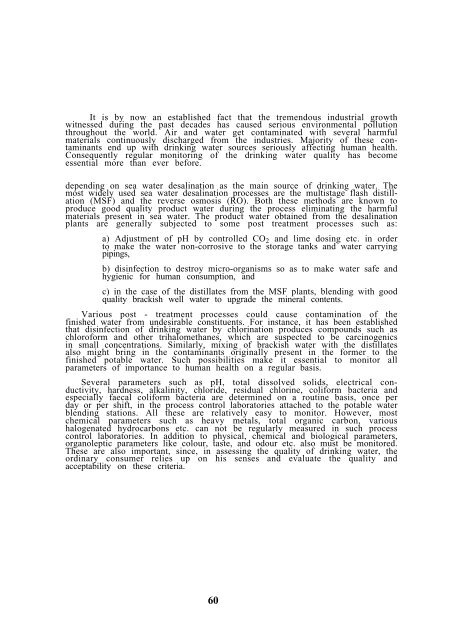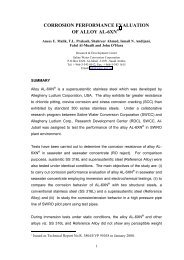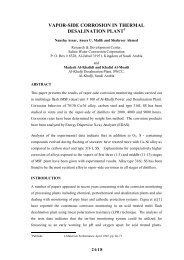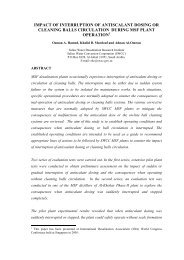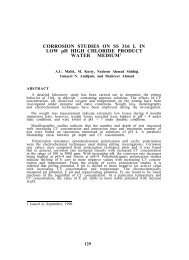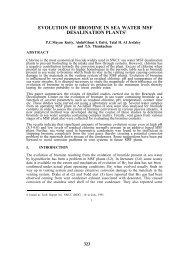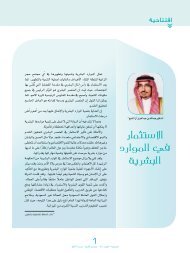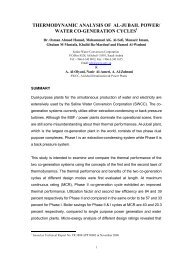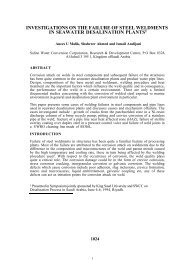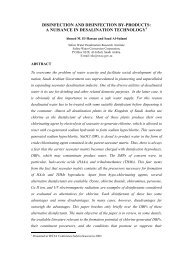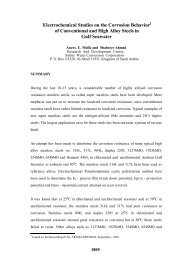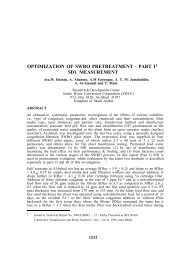quality control of potable water supplies from swcc's
quality control of potable water supplies from swcc's
quality control of potable water supplies from swcc's
Create successful ePaper yourself
Turn your PDF publications into a flip-book with our unique Google optimized e-Paper software.
It is by now an established fact that the tremendous industrial growth<br />
witnessed during the past decades has caused serious environmental pollution<br />
throughout the world. Air and <strong>water</strong> get contaminated with several harmful<br />
materials continuously discharged <strong>from</strong> the industries. Majority <strong>of</strong> these contaminants<br />
end up with drinking <strong>water</strong> sources seriously affecting human health.<br />
Consequently regular monitoring <strong>of</strong> the drinking <strong>water</strong> <strong>quality</strong> has become<br />
essential more than ever before.<br />
depending on sea <strong>water</strong> desalination as the main source <strong>of</strong> drinking <strong>water</strong>. The<br />
most widely used sea <strong>water</strong> desalination processes are the multistage flash distillation<br />
(MSF) and the reverse osmosis (RO). Both these methods are known to<br />
produce good <strong>quality</strong> product <strong>water</strong> during the process eliminating the harmful<br />
materials present in sea <strong>water</strong>. The product <strong>water</strong> obtained <strong>from</strong> the desalination<br />
plants are generally subjected to some post treatment processes such as:<br />
a) Adjustment <strong>of</strong> pH by <strong>control</strong>led CO2 and lime dosing etc. in order<br />
to make the <strong>water</strong> non-corrosive to the storage tanks and <strong>water</strong> carrying<br />
pipings,<br />
b) disinfection to destroy micro-organisms so as to make <strong>water</strong> safe and<br />
hygienic for human consumption, and<br />
c) in the case <strong>of</strong> the distillates <strong>from</strong> the MSF plants, blending with good<br />
<strong>quality</strong> brackish well <strong>water</strong> to upgrade the mineral contents.<br />
Various post - treatment processes could cause contamination <strong>of</strong> the<br />
finished <strong>water</strong> <strong>from</strong> undesirable constituents. For instance, it has been established<br />
that disinfection <strong>of</strong> drinking <strong>water</strong> by chlorination produces compounds such as<br />
chlor<strong>of</strong>orm and other trihalomethanes, which are suspected to be carcinogenics<br />
in small concentrations. Similarly, mixing <strong>of</strong> brackish <strong>water</strong> with the distillates<br />
also might bring in the contaminants originally present in the former to the<br />
finished <strong>potable</strong> <strong>water</strong>. Such possibilities make it essential to monitor all<br />
parameters <strong>of</strong> importance to human health on a regular basis.<br />
Several parameters such as pH, total dissolved solids, electrical conductivity,<br />
hardness, alkalinity, chloride, residual chlorine, coliform bacteria and<br />
especially faecal coliform bacteria are determined on a routine basis, once per<br />
day or per shift, in the process <strong>control</strong> laboratories attached to the <strong>potable</strong> <strong>water</strong><br />
blending stations. All these are relatively easy to monitor. However, most<br />
chemical parameters such as heavy metals, total organic carbon, various<br />
halogenated hydrocarbons etc. can not be regularly measured in such process<br />
<strong>control</strong> laboratories. In addition to physical, chemical and biological parameters,<br />
organoleptic parameters like colour, taste, and odour etc. also must be monitored.<br />
These are also important, since, in assessing the <strong>quality</strong> <strong>of</strong> drinking <strong>water</strong>, the<br />
ordinary consumer relies up on his senses and evaluate the <strong>quality</strong> and<br />
acceptability on these criteria.<br />
60


